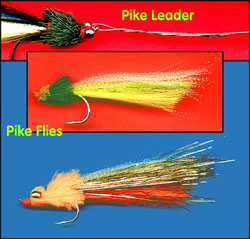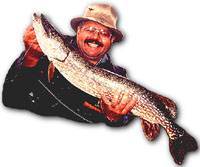Pike on the Fly
These under-rated game fish are great on fly gear!
Adapted from The Essential Guide to Fly-Fishing
by Clive Schaupmeyer
If you live where there are pike and have yet to try them with fly gear then you are in for a treat. They are a blast on a fly rod, especially in spring when their metabolism and fighting spirit are tops. Or if you've been thinking of flying to a northern lodge for ice-out pike, then wait no longer!
I prefer fly-fishing for trout, but I fly-fish for pike for a few reasons. Since I live in a prairie town, there isn't a lot of trout fly-fishing less than 2 or 3 hours away-the Bow River and a couple of local trout ponds excepted-so friends and I frequently head out in the spring and early summer in search of pre- or post-spawn pike. (There are many pike lakes within 30 minutes from home and some as close as 10 minutes.) We also fly-fish for pike in spring because that's when our foothill and mountain trout streams (that are legally open) are often high and dirty. The third reason we like to fly-fish for pike is that it is serious fun!
A 7- or 8-weight fly outfit is needed for pike: a 9-weight is fine if that's what you have. Even if the pike where you fish are not very big, a heavy rig will help you cast big streamers. A weight-forward floating line will do for most pike fishing, although you may want to consider buying a bug- or bass-tapered line if you'll be doing lots of big-fly angling. Tie on about 6 feet of 15-pound level monofilament leader with a loop tied at the fly end.
I attached 10-inch sections of plastic-coated steel leaders to each fly. The wire is passed through the hook eye and then twisted as shown. The plastic coating is fused with the flame from a lighter.  A fused loop is also made at the line end of the steel leader and connected to the mono leader with loop-to-loop connection. Some pike fly anglers prefer to use 30-pound monofilament fly leaders instead of steel. Fine. But I tried a mono leader once and lost a fair-sized pike because it hit from the side and sheared the heavy leader. A fused loop is also made at the line end of the steel leader and connected to the mono leader with loop-to-loop connection. Some pike fly anglers prefer to use 30-pound monofilament fly leaders instead of steel. Fine. But I tried a mono leader once and lost a fair-sized pike because it hit from the side and sheared the heavy leader.
My favorite fly color combinations include brass flash filaments mixed with orange artificial hair, and chartreuse and yellow, again with a few flash filaments. Streamers that look more like local bait fish are also popular: light-colored undersides with dark backs and a few silvery flash filaments. Hook sizes range from 2 to 2/0 or 3/0. Overall fly lengths vary from 3 to 8 inches, although I prefer 4 or 5 inch pike flies.
Artificial fibers are preferred for large pike flies. These fibers do not hold water that adds unnecessary weight when casting. The nonabsorbent artificial fibers (like fish hair, Big Fly Fiber and various brands of flash strands) drain instantly, unlike natural tying materials like rabbit fur and marabou feathers. These look great, but absorb lots of water and increase casting difficulty.
Not a lot to say about technique.  Try various depths and strip speeds until something works. You may have to use a sinking-tip line later in the year when the pike move to deeper, cooler water, but most of the time they will be shallow enough to use a floating line. If pike are in more than a few feet of water, adding one or two split shots to the leader will help sink the fly. Try various depths and strip speeds until something works. You may have to use a sinking-tip line later in the year when the pike move to deeper, cooler water, but most of the time they will be shallow enough to use a floating line. If pike are in more than a few feet of water, adding one or two split shots to the leader will help sink the fly.
Strip speeds don't have to be fast, but they need to be lively. Sluggish retrieves just don't get pike excited. If there are feeding pike in the neighborhood, short, snappy 4-inch strips are usually adequate to stimulate a strike. When the water is clear you might be able to see a pike follow your streamer. If the fish seems hesitant, let the fly drop a few inches. They'll sometimes hit a dropping lure.
So where are pike likely to be? My experience is you'll want to be fishing in bays until late spring or early summer. Pike like to hang out in tall weed cover, on the edge of tall weed beds or suspended over or just in, short weed beds. In early spring you can wade and cast to pike in shallow water. However, after the spawn, they head to deeper water and some sort of water-craft will be required.
About the only extra equipment you'll need are jaw spreaders and long-nosed forceps (or long needle-nosed pliers). Oh yes-don't "lip" pike.
Closing thoughts: Minds are like parachutes. They only function when they are open. (Sir James Dewar, Scientist, 1877-1925). - CS
Return to Index
Copyright ©1998 Clive Schaupmeyer
Clive Schaupmeyer is an outdoor writer and photographer. He is the author of
The Essential Guide to Fly-Fishing,
a 288-page book for novice and intermediate fly anglers. His photo of a boy
fishing was judged the best outdoor picture of 1996 published by a member of
the Outdoor Writers of Canada. He fly-fishes for trout in Alberta's foothill
and mountain streams and for pike near his home in Brooks, Alberta.
Our Man In Canada Archives
|


 A fused loop is also made at the line end of the steel leader and connected to the mono leader with loop-to-loop connection. Some pike fly anglers prefer to use 30-pound monofilament fly leaders instead of steel. Fine. But I tried a mono leader once and lost a fair-sized pike because it hit from the side and sheared the heavy leader.
A fused loop is also made at the line end of the steel leader and connected to the mono leader with loop-to-loop connection. Some pike fly anglers prefer to use 30-pound monofilament fly leaders instead of steel. Fine. But I tried a mono leader once and lost a fair-sized pike because it hit from the side and sheared the heavy leader. Try various depths and strip speeds until something works. You may have to use a sinking-tip line later in the year when the pike move to deeper, cooler water, but most of the time they will be shallow enough to use a floating line. If pike are in more than a few feet of water, adding one or two split shots to the leader will help sink the fly.
Try various depths and strip speeds until something works. You may have to use a sinking-tip line later in the year when the pike move to deeper, cooler water, but most of the time they will be shallow enough to use a floating line. If pike are in more than a few feet of water, adding one or two split shots to the leader will help sink the fly.